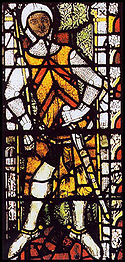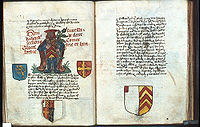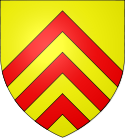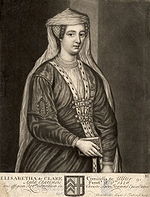- de Clare
-
The de Clare family of Norman lords were associated with the Welsh Marches, Suffolk, Surrey, Kent (especially Tonbridge) and Ireland. They were descended from Richard fitz Gilbert, who accompanied William the Conqueror into England during the Norman conquest of England.
Contents
Origins
 Stained glass window depicting a Gilbert de Clare, Tewkesbury Abbey.
Stained glass window depicting a Gilbert de Clare, Tewkesbury Abbey.
The Clare family descends from Gilbert Crispin, Count of Brionne and Eu, whose father Godfrey was the eldest of the illegitimate sons of Richard I, Duke of Normandy. Gilbert was one of the guardians of William II, who became Duke of Normandy as a child in 1035. When Gilbert was assassinated in 1039 or 1040, his young sons Baldwin de Meules et du Sap and Richard de Bienfaite et d'Orbec fled with their guardians to Baldwin of Flanders; they returned to Normandy when William married Baldwin's daughter in 1053, and William took them into high favour.
After the conquest of England Richard received huge estates including Clare and Tonbridge, the estate whose name was normally coupled with his. According to Richard Mortimer, writing in the Oxford Dictionary of National Biography, he was "the founder of the English, Welsh, and Irish baronial family which historians usually call ‘of Clare’."[1] Historical sources are vague and sometimes contradictory about when the name de Clare came into common usage, but Richard fitz Gilbert (of Tonbridge) is once referred to as Richard of Clare in the Suffolk return of the Domesday Survey.[2] Baldwin de Meules was left in charge of Exeter on its submission (1068) and made sheriff of Devonshire. Large estates in Devonshire and Somersetshire are entered to him in Domesday as "Baldwin of Exeter" or "Baldwin the Sheriff".
On his death, Richard's English estates passed to his son Gilbert Fitz Richard (died 1114/7). Gilbert's eldest son Richard (died ca. 1136) was the ancestor of the earls of Hertford and Gloucester. Gilbert's younger son Gilbert, establishing himself in Wales, acquired the earldom of Pembroke or of Striguil. The elder line obtained (probably from King Stephen)[3] the earldom of Hertford, and were thenceforth known as earls of Hertford or of Clare. John Horace Round in the Encyclopædia Britannica Eleventh Edition suggested that it was probably because "[Gilbert] and the Clares had no interests in Hertfordshire that they were loosely and usually styled the earls of (de) Clare."[3] In the Dictionary of National Biography he stated that investigation showed that the claim that they were "styled earls of Clare" before they were earls of Hertford was not true; they were alternately called Hertford or of Clare.[4] On the other hand, Frank Barlow places Gilbert de Clare as Earl of Hertford in the group of barons given earldoms between 1138 and 1142, and states that they all had "substantial local interests".[5] Ralph Henry Carless Davis states that Gilbert was a witness as Earl of Hertford at Christmas 1141, and it is generally believed that he had been Earl since 1138; but that there is no prospect of clarifying the matter because of the others of the same name. He notes also that "In a military capacity earls figure largely in the capacity of defenders of their counties in the chronicles of Stephen's reign." He therefore argues against the title as a personal dignity at that period.[6] The general scholarly view is now that the title earl of Clare was self-assumed.
 Arms of Richard de Clare II, Earl of Hertford and Gloucester, Founders book of Tewkesbury Abbey, c. 1525
Arms of Richard de Clare II, Earl of Hertford and Gloucester, Founders book of Tewkesbury Abbey, c. 1525
In 1217–20 Gilbert de Clare, earl of Hertford or Clare (died 1230), inherited the estates of William Fitz Robert, 2nd Earl of Gloucester (died 1183), including the earldom and honour of Gloucester and the lordship of Glamorgan. Richard de Clare, 2nd Earl of Pembroke (died 1176), known as Strongbow, had no sons and with his death this line came to an end, his many Irish and Welsh possessions passing to his daughter Isabel, who married William Marshal, (c. 1146 – 14 May 1219) who then became known as William Marshal, 1st Earl of Pembroke.[7]
Coat of arms
The coat and shield with the three chevrons was probably first used at the end of the 12th century.[8] The stained glass window above is not earlier than Gilbert I (died 1230), the first de Clare lord to be buried in the chancel of Tewkesbury Abbey. The coat of arms can be seen in a modern-day context within the arms of Pontypridd Rugby Football Club.
Genealogical tables
Origins and family ties with notable members of Clare.
Main table: the origins
Richard I, Duke of Normandy († 996) │ └>Geoffrey, Count of Eu († 1015) │ └>Gilbert, Count of Brionne († 1040), Count of Eu │ ├─>Baldwin fitz Gilbert († 1090), Lord of Sap and Meules, │ Lord of Okehampton, Sheriff of Devon. [ de Clare Family ] │ └─>Richard fitz Gilbert († 1090), Lord of Bienfaite and of Orbec, │ also Lord of Clare and of Tonbridge, Joint Chief Justiciar of England │ ├─>Roger († 1131), Lord of Bienfaite and of Orbec │ ├─>Robert († 1134), Lord of Little Dunmow (Essex) │ ├─>Richard, Abbot of Ely │ ├─>Walter († 1138), Lord of Netherwent │ └─>Gilbert († 1117), Lord of Clare, Tonbridge and Cardigan │ ├─>Richard († 1136), sometimes designated as Earl of Hertford │ ├─>Gilbert († 1148/49), 1st Earl of Pembroke, │ successor to his uncles Roger and Walter │ └─>Baldwin († 1154/1166), Lord of Bourne
Table 2 : descendants of Richard fitz Gilbert de Clare the second
Gilbert († 1117), Lord of Clare and of Tonbridge and Cardigan │ ├─>Richard († 1136), Lord of Clare, Tonbridge and Cardigan │ │ │ ├─>Gilbert († 1152), 1st Earl of Hertford │ │ │ ├─>Roger sometimes called the good Earl of Hertford († 1173), 2nd Earl of Hertford │ │ │ │ │ ├─>Richard († 1217), 3rd Earl of Hertford and 1st of Gloucester │ │ │ Amicie de Gloucester, countess de jure of Gloucester │ │ │ │ │ │ │ └─> Table 3 │ │ │ │ │ └─>Aveline († 1164), married Geoffrey fitz Piers, 1st Earl of Essex │ │ │ ├─>Rohaise, married Gilbert de Gant, Earl of Lincoln │ │ │ ├─>Alice, married Cadwaladr ap Gruffydd, prince of Gwynedd │ │ │ └─>Lucy, married Baldwin de Redvers, 1st Earl of Devon │ ├─>Gilbert († 1148/49), 1st Earl of Pembroke (1138) │ │ x Isabelle de Beaumont, │ │ daughter of Robert de Beaumont, 1st Earl of Leicester │ │ │ └─>Richard also called Strongbow († 1176), 2nd Earl of Pembroke │ │ attempted to take control of Ireland │ │ │ ├─>Gilbert of Striguil (1173–1185), 3rd Earl of Pembroke │ │ │ └─>Isabelle († 1220) │ x William Marshal became the first Earl of Pembroke │ This branch of the family being extinguished. │ └─>Baldwin († 1154), Lord of Bourne
Table 3 : descendants of Richard, 3rd Earl of Hertford
Richard († 1217), 3rd Earl of Hertford and Gloucester │ Amicie of Gloucester, Countess de jure of Gloucester │ ├─>Gilbert († 1230), 4th Hertford and 5th Earl of Gloucester │ │ x Isabelle, daughter of William Marshal, 1st Earl of Pembroke, │ │ heir of the younger branch of Clare (see table 2) │ │ │ │ │ ├─>Richard († 1262), 5th Earl of Hertford, 6th Earl of Gloucester │ │ │ │ │ ├─>Gilbert also known as the Red Earl († 1295), 6th Earl of Hertford, 7th Earl of Gloucester │ │ │ │ Co-guardian of England in the death of King Henry III of England │ │ │ │ │ │ │ └─>Gilbert († 1314), 7th Hertford and 8th Earl of Gloucester │ │ │ │ │ │ │ │ ├─>Bogo (1248–1294), member of the clergy │ │ │ │ │ └─>Thomas († 1287), Lord of Thomond, Chancellor of Ireland │ │ │ └─>Isabelle († 1264), married Robert de Brus, 5th Lord of Annandale │ │ │ └─> The Ascendents Kings of Scotland of the House of Bruce. │ └─>Mathilde, married Rhys ap Rhys († 1234), prince of Deheubarth
Bibliography
- J. C. Ward, "Fashions in monastic endowment: the foundations of the Clare family, 1066–1314", Journal of Ecclesiastical History, vol. 32 (1981), p. 427-451.
- J. C. Ward, "Royal service and reward: the Clare family and the crown, 1066–1154", Anglo-Norman Studies, vol. 11 (1988), p. 261-278.
- Michael Altschul, A Baronial Family in Medieval England: The Clares, 1217-1314, The Johns Hopkins Press, Baltimore, 1965. See online summary.
References
- ^ Richard Mortimer, Clare, Richard de [Richard fitz Gilbert] (1030x35–1087x90), magnate, in the Oxford Dictionary of National Biography, online by subscription.
- ^ Suffolk return of the Domesday Survey (c. 1086) (ed. A. Rumble, Suffolk, 2 vols (Chichester, 1986), 67 ~ 1
- ^ a b John Horace Round, 1911 Britannica article Clare (Family), http://www.1911encyclopedia.org/Clare_%28Family%29.
- ^ s:Page:Dictionary of National Biography volume 10.djvu/383
- ^ Frank Barlow, The Feudal Kingdom of England, 1042-1261 (4th edition 1988), p. 213.
- ^ R. H. C. Davis, King Stephen (1977), p. 136, and p. 129.
- ^ Dictionary of National Biography, edited by Leslie Stephen, Vol X. p. 375-
- ^ The Archaeological Journal, Article 51, pg 43- published under the direction of The Council of The Royal Archaeological Insutute of Great Britain and Ireland, available at Google books online at http://books.google.com/books?id=yZg8AAAAIAAJ&pg=PA48
External links
Categories:- Anglo-Normans
- Anglo-Norman families
- Anglo-Normans in Wales
- English families
- De Clare family
- Anglo-Norman Irish dynasties
Wikimedia Foundation. 2010.



